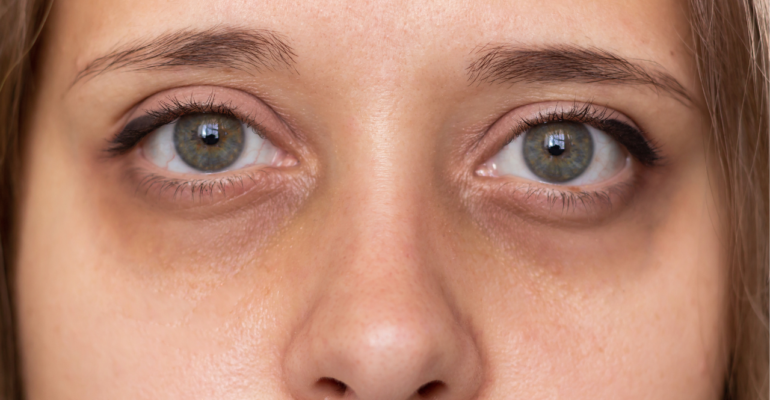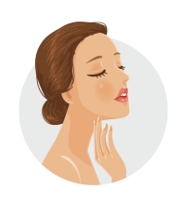11 Types of dark circles: Find your type?
April 23, 2025 2025-04-23 8:4711 Types of dark circles: Find your type?
As an Amazon associate, Dermatocare earns from valid purchase made by clicking on the affiliate links in this blog.

11 Types of dark circles: Find your type?
Dark circles are among the most common cosmetic concerns in dermatology, yet their root causes can be multifactorial and often misunderstood. A one-size-fits-all approach rarely works—what you need is a personalized solution based on the type of dark circles you have. This article explores the 8 types of dark circles, how to identify them, their underlying causes, and the best ingredients or treatments tailored to each type.
Let’s delve into the intriguing realm of dark circles and decipher their various forms:
1. Pigmented Dark Circles:

How to Identify:
Dark brown to black hue under the eyes, often more prominent in individuals with medium to dark skin tones. They are visible even when the skin is gently stretched.
Cause:
Excess melanin production due to genetic predisposition, chronic rubbing, sun exposure, or post-inflammatory hyperpigmentation.
Best Ingredients/Treatment:
Look for niacinamide, kojic acid, arbutin, licorice extract, vitamin C, and retinoids in eye creams. Chemical peels (e.g., glycolic acid), laser toning, or micro needling with tranexamic acid can also help.
2. Vascular Dark Circles:

How to Identify:
Bluish, purplish, or pinkish discoloration under the eyes that worsens with fatigue, stress, or allergies. The discoloration becomes less visible when the skin is stretched.
Cause:
Visible underlying blood vessels due to thin skin or blood pooling from poor circulation.
Best Ingredients/Treatment:
Opt for caffeine, vitamin K, peptides, and cold compresses. Procedures such as PRP (platelet-rich plasma), mesotherapy, or vascular lasers (e.g., pulsed dye laser) may be beneficial.
3. Puffy Eyes or Eye Bags:

- Cause: Puffy eyes typically result from water retention at a younger age or fat protrusion in later years. If your eye bags fluctuate over time, water retention is likely the root cause.
- Appearance: You’ll notice a bulging under-eye area.
- Solution: Treatment for eye bags differs—find more about it in our article “How To Get Rid Of Puffy Eyes Or Eye Bags: Interview With Best Plastic Surgeon.”
4. Depression in Under-Eye Area:

- Cause: Depression in the under-eye area is a common occurrence with age, usually due to sagging cheeks. This can also be referred to as tear trough deformity. However, if you encounter a trough below your eye at a young age, it’s termed as Arcus deformity.
- Appearance: A noticeable trough beneath the eye; these dark circles vanish when you stretch the under-eye skin.
- Solution: Troughs reside at deeper levels, making eye creams ineffective. Hyaluronic acid fillers in the tear trough area are the treatment of choice. Supportive creams with peptides and collagen-boosters can help improve skin quality.
5. Wrinkles and Fine Lines in Under-Eye Skin:

- Cause: Wrinkles and fine lines can cast a shadow and give a darker appearance to the under-eye skin.
- Solution: Guard your under-eye area with sun protection—sport oversized sunglasses to shield from UV rays or use sunscreen. Peptide or retinol-based eye creams might work for fine lines, and Botox injections are recommended for crow’s feet.
6. Dark Circles Involving Cheek and Forehead:
- Cause: Dark circles that stretch to the adjacent cheeks and forehead often stem from hereditary conditions like Pigment Demarcation Line and Dermal Melanocytosis.
- Appearance: These dark circles are typically brown, bluish, or blackish and extend to the adjacent areas, characterized by sharp, straight borders.
- Solution: LASERS may offer potential solutions for this category of dark circles.
7. Deep-Seated Eyes:

- Cause: Deep-set eyes are a distinctive case where the bone beneath the eyebrow casts a shadow in the under-eye area.
- Appearance: Dark circles due to shadow vanish when you look upward.
- Solution: Regrettably, in such instances, there’s not much that can be done except rocking fashionable zero-powered spectacles
8. Fatigue-Induced Dark Circles
How to Identify:
Temporary dark circles that appear after poor sleep or stress and improve with rest.
Cause:
Poor lymphatic drainage, stress-related vasodilation, and dehydration.
Best Ingredients/Treatment: Caffeine, green tea extract, vitamin C, and niacinamide. Cold compresses and adequate hydration can also be effective.4
9. Allergic or Rubbing-Induced Dark Circles
How to Identify:
Darkening worsens with itching, rubbing, or allergy symptoms like sneezing. Known as “allergic shiners.”
Cause:
Chronic eye rubbing and inflammation due to allergies or atopic dermatitis.
Best Ingredients/Treatment: Use anti-inflammatory ingredients like allantoin, niacinamide, and azelaic acid. Treat underlying allergies with antihistamines and avoid rubbing. Barrier repair creams with ceramides are recommended.
10 . Post-Inflammatory Hyperpigmentation
How to Identify:
Brown discoloration following eczema, dermatitis, or irritation around the eyes.
Cause:
Melanin overproduction triggered by skin inflammation or injury.
Best Ingredients/Treatment: Hydroquinone (under supervision), azelaic acid, licorice extract, kojic acid, and tranexamic acid. Avoid irritants and always use sunscreen.
10. Multifactorial:

- Cause: Most dark circles are complex and might encompass multiple types listed above.
- Solution: Your dermatologist is your best ally in unraveling this mystery, examining your unique case, and determining the most suitable solution.
Conclusion: Personalized Treatment Is Key
Not all dark circles are created equal, and neither should be the approach to treating them. Identifying the correct type is crucial to choosing the right ingredients and procedures. At Dermatocare, we specialize in offering AI-driven, dermatologist-curated recommendations to match the best eye cream or treatment for your specific type of dark circles.
➡️ Read 10 Best Eye Cream: Dermatologist pick to get your customized recommendation today!
ROUTINE FINDER
Get free dermatologist-recommended regime by choosing your skin or concerns.

FACE

HAIRS

CHILD

BODY




